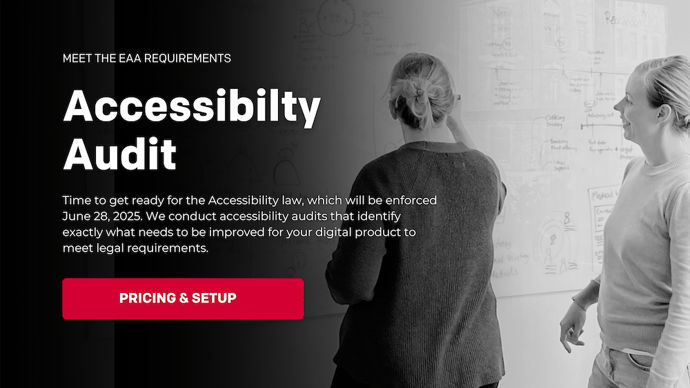The new Accessibility Act, coming into force in June 2025, sets clear requirements for digital services and products to be accessible - not as a recommendation, but as a legal obligation. In this guide, we’ll walk you through the technical requirements, guidelines, and standards that apply, and how to ensure your digital solution complies with them.
Technical requirements in practice
The new legislation requires that digital interfaces must:
- Be fully usable without a mouse (complete keyboard navigation)
- Provide sufficient contrast between text and background
- Offer alternative text for images and graphics
- Be semantically structured so screen readers can interpret the content correctly
- Be responsive and work across different screen sizes and devices (including up to 200% zoom without loss of functionality)
- Display clear error messages and support form handling with assistive technologies
- Be usable by individuals with cognitive disabilities or motor impairments
Key guidelines and standards
To interpret and comply with the law, the following technical frameworks are used:
-
1. WCAG 2.1 Level AA (Web Content Accessibility Guidelines)
This is the primary standard the legislation is based on, comprising 50+ guidelines under four core principles:
- Perceivable – information must be presented in ways users can perceive
- Operable – user interface components must be usable
- Understandable – information and operation must be comprehensible
- Robust – content must be compatible with current and future technologies
Examples of WCAG 2.1 AA requirements:
- Minimum color contrast ratio of 4.5:1
- Keyboard navigation throughout the interface
- Logical heading structure (H1, H2, H3…)
- Focus indicators showing the user's current location
- 2. EN 301 549 – The European Standard for Accessible ICT
This is the harmonized standard referenced by the EU, containing detailed technical requirements for:
- Websites and apps
- Software and operating systems
- Electronic communication and documents
EN 301 549 incorporates WCAG 2.1 for web content but also adds requirements such as:
- Speech synthesis compatibility
- Accessibility in hardware interfaces (e.g. ATMs, terminals)
- Document formats, such as accessible PDFs (PDF/UA compliance)
- 3. ARIA (Accessible Rich Internet Applications)
ARIA attributes enhance accessibility in modern web applications where HTML alone falls short. They make components like modals, sliders, and dropdowns accessible to screen readers.
Example:
role="dialog" or aria-expanded="true" provide context for screen reader users.
⚠️ Caution: Incorrect use of ARIA can harm accessibility. Use it sparingly and correctly.
Important considerations during implementation
- Keyboard support is not optional – the entire interface must be navigable without a mouse.
- Semantics matter – proper HTML elements ensure correct functionality with assistive tools.
- Accessible design is good design for everyone – for example, high contrast also benefits users in bright light or on small screens.
- Test with assistive technologies – use screen readers, magnifiers, and keyboard-only navigation.
- Automated testing isn’t enough – complement with manual testing and user testing.
How to get started
-
- 1. Use a WCAG checklist tool such as WAVE, Axe, or Lighthouse.
-
- 2. Educate developers and designers on WCAG and EN 301 549 standards.
-
- 3. Include accessibility reviews as part of your QA process.
-
- 4. Build accessible components from the ground up – use design systems that support ARIA and semantic HTML.
-
- 5. Create and maintain an accessibility statement on your website to meet legal documentation requirements. [Download a template here 👇]

Summary
Complying with the Accessibility Act is not just a legal obligation — it’s a mark of quality for your digital product. With the right guidelines, the right expertise, and ongoing testing, accessibility becomes not a barrier, but a natural part of the development process.
Our accessibility audits highlight exactly where your digital service falls short – and how to fix it to meet legal standards.
Find out more here.

![PH_wp_[EN]_Blog listing - banner](https://qestit.com/hubfs/Website/Web%20pages%20photos/PH_wp_%5BEN%5D_Blog%20listing%20-%20banner.jpeg)



.jpg)



